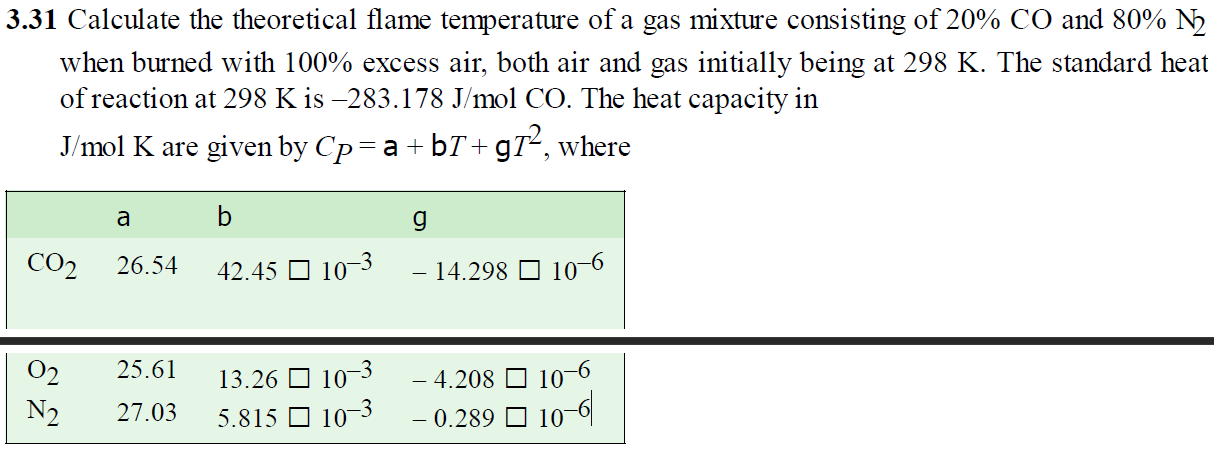3.31 Calculate the theoretical flame temperature of a gas mixture consisting of 20% CO and 80% N2 when burned with 100% excess air, both air and gas initially being at 298 K. The standard heat of reaction at 298 K is –283.178 J/mol CO. The heat capacity in J/mol K are given by Cp= a + bT+gT², where a b CO2 26.54 42.45 O 10-3 - 14.298 O 10–6 02 25.61 13.26 O 10-3 5.815 O 10-3 - 4.208 O 10–6 - 0.289 O 10-6 N2 27.03
3.31 Calculate the theoretical flame temperature of a gas mixture consisting of 20% CO and 80% N2 when burned with 100% excess air, both air and gas initially being at 298 K. The standard heat of reaction at 298 K is –283.178 J/mol CO. The heat capacity in J/mol K are given by Cp= a + bT+gT², where a b CO2 26.54 42.45 O 10-3 - 14.298 O 10–6 02 25.61 13.26 O 10-3 5.815 O 10-3 - 4.208 O 10–6 - 0.289 O 10-6 N2 27.03
Introduction to Chemical Engineering Thermodynamics
8th Edition
ISBN:9781259696527
Author:J.M. Smith Termodinamica en ingenieria quimica, Hendrick C Van Ness, Michael Abbott, Mark Swihart
Publisher:J.M. Smith Termodinamica en ingenieria quimica, Hendrick C Van Ness, Michael Abbott, Mark Swihart
Chapter1: Introduction
Section: Chapter Questions
Problem 1.1P
Related questions
Question
Calculate the theoretical flame temperature of a gas mixture consisting of 20% CO and 80% N2
when burned with 100% excess air, both air and gas initially being at 298 K. The standard heat
of reaction at 298 K is –283.178 J/mol CO. The heat capacity in
J/mol K are given by CP = a + bT + gT2, where
a b g
CO2 26.54 42.45 ? 10–3 – 14.298 ? 10–6
O2 25.61 13.26 ? 10–3 – 4.208 ? 10–6
N2 27.03 5.815 ? 10–3 – 0.289 ? 10–6

Transcribed Image Text:3.31 Calculate the theoretical flame temperature of a gas mixture consisting of 20% CO and 80% N2
when burned with 100% excess air, both air and gas initially being at 298 K. The standard heat
of reaction at 298 K is –283.178 J/mol CO. The heat capacity in
J/mol K are given by Cp= a + bT+gT², where
a
b
CO2
26.54
42.45 O 10-3
- 14.298 O 10–6
02
25.61
13.26 O 10-3
5.815 O 10-3
- 4.208 O 10–6
- 0.289 O 10-6
N2
27.03
Expert Solution
This question has been solved!
Explore an expertly crafted, step-by-step solution for a thorough understanding of key concepts.
Step by step
Solved in 8 steps with 14 images

Knowledge Booster
Learn more about
Need a deep-dive on the concept behind this application? Look no further. Learn more about this topic, chemical-engineering and related others by exploring similar questions and additional content below.Recommended textbooks for you

Introduction to Chemical Engineering Thermodynami…
Chemical Engineering
ISBN:
9781259696527
Author:
J.M. Smith Termodinamica en ingenieria quimica, Hendrick C Van Ness, Michael Abbott, Mark Swihart
Publisher:
McGraw-Hill Education

Elementary Principles of Chemical Processes, Bind…
Chemical Engineering
ISBN:
9781118431221
Author:
Richard M. Felder, Ronald W. Rousseau, Lisa G. Bullard
Publisher:
WILEY

Elements of Chemical Reaction Engineering (5th Ed…
Chemical Engineering
ISBN:
9780133887518
Author:
H. Scott Fogler
Publisher:
Prentice Hall

Introduction to Chemical Engineering Thermodynami…
Chemical Engineering
ISBN:
9781259696527
Author:
J.M. Smith Termodinamica en ingenieria quimica, Hendrick C Van Ness, Michael Abbott, Mark Swihart
Publisher:
McGraw-Hill Education

Elementary Principles of Chemical Processes, Bind…
Chemical Engineering
ISBN:
9781118431221
Author:
Richard M. Felder, Ronald W. Rousseau, Lisa G. Bullard
Publisher:
WILEY

Elements of Chemical Reaction Engineering (5th Ed…
Chemical Engineering
ISBN:
9780133887518
Author:
H. Scott Fogler
Publisher:
Prentice Hall


Industrial Plastics: Theory and Applications
Chemical Engineering
ISBN:
9781285061238
Author:
Lokensgard, Erik
Publisher:
Delmar Cengage Learning

Unit Operations of Chemical Engineering
Chemical Engineering
ISBN:
9780072848236
Author:
Warren McCabe, Julian C. Smith, Peter Harriott
Publisher:
McGraw-Hill Companies, The